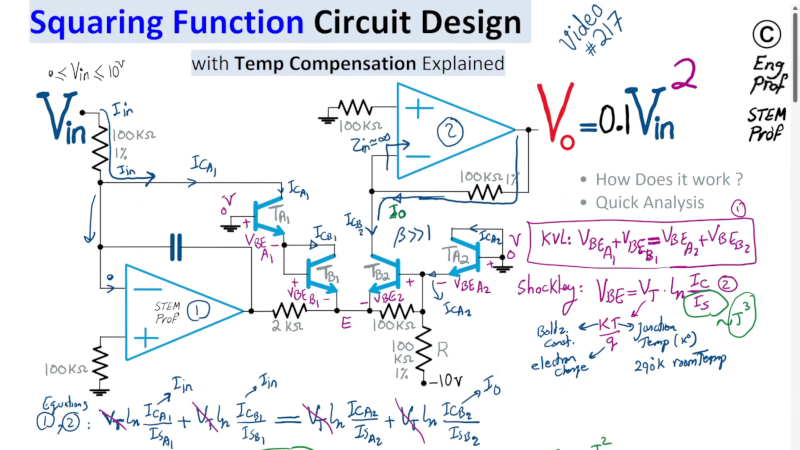
In the world of electronics, the challenge of manipulating voltage is a constant pursuit. Engineers are now tasked with a fascinating problem: squaring an input voltage and producing a manageable output. While squaring 8 volts would typically result in 64 volts, the goal here is to achieve only 10% of that square, resulting in an output of 6.4 volts. This intriguing task is being explored by engineering experts, who are demonstrating innovative solutions through video tutorials.
The solution involves a complex circuit design utilizing two operational amplifiers (op amps) and a set of transistors. However, the transistors are not used in a conventional manner. Their operation depends significantly on temperature, necessitating the use of a transistor array to ensure they are matched and maintain the same temperature. This is crucial for the circuit’s accuracy and reliability.
Understanding the Circuitry
The core of this design lies in the mathematical properties of transistors. The response of a transistor includes a natural logarithm term, allowing the use of logarithmic identities to simplify the design. Specifically, the sum of two logarithms is equivalent to the logarithm of the product of the numbers, a principle that plays a pivotal role in the circuit’s functionality.
By matching the transistors, many terms in the equation cancel out, simplifying the calculations. Since transistors are current-driven devices, the circuit’s output current is the input current squared, divided by the collector current of the output transistor. The challenge then becomes converting this current back into a voltage, which is achieved through precise scaling techniques.
Practical Applications and Implications
This development is not just an academic exercise but has significant practical implications. Squaring a voltage is a fundamental operation in analog computing, where precise voltage manipulation is essential for complex calculations. This innovative circuit design could pave the way for more advanced analog computing systems, offering a new approach to handling complex mathematical operations in hardware.
Furthermore, the ability to accurately square a voltage with minimal error opens up possibilities in various fields, including signal processing and instrumentation. Engineers and researchers can apply these principles to develop more efficient and accurate electronic systems.
Expert Insights and Future Directions
According to engineering experts, the use of matched transistor arrays is a critical advancement in this design. By ensuring all transistors operate at the same temperature, the circuit maintains stability and precision. This approach highlights the importance of thermal management in electronic circuit design, a factor that is often overlooked but crucial for performance.
“The key to this design is understanding the logarithmic properties of transistors and leveraging them to simplify complex calculations,” said a leading engineering professor involved in the project.
Looking forward, this innovative approach to voltage manipulation could inspire further research into analog computing and its applications. As digital systems continue to dominate, the resurgence of interest in analog techniques could lead to hybrid systems that combine the best of both worlds.
For those interested in delving deeper into the mathematics and technical details, the video tutorial provides a comprehensive explanation. It also offers a refresher on Kirchhoff’s Current Law (KCL), which is foundational to understanding circuit behavior.
As technology continues to evolve, the ability to creatively solve complex problems like voltage squaring will remain a vital skill for engineers. This development not only showcases the ingenuity of modern engineering but also sets the stage for future innovations in electronic design.






